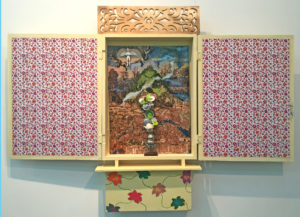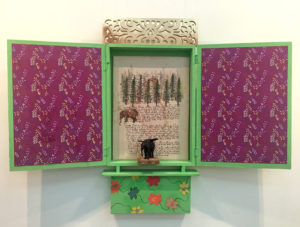 Indian artist A Naveen Kumar has packed a thousand years of history and the latest in advanced technology into his 8 x 10 studio in Bangalore. And this month, he’s unpacked them in an exhibit entitled 81 sqft Studio, on display until September 19, at Gallery Sumukha in Wilson Garden. The work that is being displayed explores ideas of modern Bangalorean life and its tension with Indian history and tradition. The media that Kumar chose is ideal for that investigation: a combination of pen and ink, paper, sculpture, and 3D printing. This is a bold move for a young artist, as Jayanthi Madhukar of The Bangalore Mirror notes, “There hasn’t been such an attempt in the city in recent memory at least.”
Indian artist A Naveen Kumar has packed a thousand years of history and the latest in advanced technology into his 8 x 10 studio in Bangalore. And this month, he’s unpacked them in an exhibit entitled 81 sqft Studio, on display until September 19, at Gallery Sumukha in Wilson Garden. The work that is being displayed explores ideas of modern Bangalorean life and its tension with Indian history and tradition. The media that Kumar chose is ideal for that investigation: a combination of pen and ink, paper, sculpture, and 3D printing. This is a bold move for a young artist, as Jayanthi Madhukar of The Bangalore Mirror notes, “There hasn’t been such an attempt in the city in recent memory at least.”
Among the most captivating pieces at the show are a series of Kavad boxes, an indigenous storytelling device from Rajasthan, that portray the collision between history and present. A Kavad box was traditionally something that was carried around by storytellers who would open a few panels of their box to intrigue passers-by and then begin opening and closing more of the doors to reveal the rest of their stories, sometimes over a period of days. In return for their storytelling they would be given money, food, and sometimes places to sleep if their tales were particularly long. Kumar’s Kavad boxes are a single compartment, but each contains not only silk screen, pen and ink, and acrylic, but 3D printed sculpture as well.
- [Images provided by A Naveen Kumar]
One of the issues that is a recurrent theme throughout the exhibit is the difficulties faced by a young person in Bangalore as they attempt to create a life for themselves. The very title of the exhibit is a reference to the sky-high prices of real estate in Bangalore, while also representing a dream that many young people in Bangalore have: that of owning their own home. A space in which to practice the acts of living is a dream that many are unable to obtain in spite of the fact that massive amounts of new housing stock is being created every year.
 One piece, a chair with an upholstered seat and an elaborately pierced filigree back representing a tree that is growing from a pot, references the desire to own material goods, to have a safe place to land – a seat being a well-understood reference to a residence – and yet the back is broken and the aspiration is anything but settled. Entitled “Dreams Stapled Together,” the piece appears to flower but the message is anything but one of certainty of success.
One piece, a chair with an upholstered seat and an elaborately pierced filigree back representing a tree that is growing from a pot, references the desire to own material goods, to have a safe place to land – a seat being a well-understood reference to a residence – and yet the back is broken and the aspiration is anything but settled. Entitled “Dreams Stapled Together,” the piece appears to flower but the message is anything but one of certainty of success.
It is within this confined space that the artist’s mind has been allowed to wander over vast spaces, bringing together an understanding of the past with visions for a future filled with an uncertainty of attainment but no lessening of desire. In the whirl and movement of contemporary life, Kumar’s artistic landscape is filled with fragments, and yet instead of being discretely imagined, they are all part of a psychological tapestry. As critic Sandhya Annaiah suggested:
“[Kumar’s] quirky means of representation techniques takes us through a journey to demonstrate how fragmented ideas capture an artist’s interest and the consequent role of the artist’s creative process in bringing these random pieces to fit together to form a larger picture. From imperial ships to a Kathakkali performer, from Victorian designs to Rajasthan’s folk Kavad all occupy a common space – and just as we look for a deeper story to connect the dots, the pictures constantly hint and exist as nothing but the visual translation of the artist’s mind. It is a brief map representing the ideas that are yet to grow before they emerge as individual tales.”
 Other works deal in issues of negotiating identity in modern Bangalore without losing the ties to tradition, rapid urbanization and deforestation, and the hopes for success by an emerging artist. The choice to 3D print the sculptures was not an easy one as Kumar has no expertise in the area. Instead, he worked with an expert in 3D printing, who was himself no artist. The pair then had to engage in extensive work sessions to ensure that both the technical and artistic requirements of the pieces were fulfilled.
Other works deal in issues of negotiating identity in modern Bangalore without losing the ties to tradition, rapid urbanization and deforestation, and the hopes for success by an emerging artist. The choice to 3D print the sculptures was not an easy one as Kumar has no expertise in the area. Instead, he worked with an expert in 3D printing, who was himself no artist. The pair then had to engage in extensive work sessions to ensure that both the technical and artistic requirements of the pieces were fulfilled.
The sculptures themselves, 40 in all, were printed using sugarcane fiber and resin, some taking as long as 18 hours to print. After printing, the statues were coated with varnish and then left on the windowsill to dry. And even the space of this sill was precious, forming the final square foot in Kumar’s 81-square-foot studio, which, until bigger dreams can be realized, also serves as his bedroom.
What do you think of these works? Let us know your thoughts; join the discussion of this and other 3D printing topics at 3DPrintBoard.com, or share your thoughts below.
Subscribe to Our Email Newsletter
Stay up-to-date on all the latest news from the 3D printing industry and receive information and offers from third party vendors.
Print Services
Upload your 3D Models and get them printed quickly and efficiently.
You May Also Like
Consolidation in AM: How 2025 Is Shaping the Industry’s New Normal
The first half of 2025 has been marked by a clear shift in the additive manufacturing (AM) industry. Companies are no longer just focused on developing new tech by themselves....
Etsy Design Rule Change Reduces Selection of 3D Printed Goods
Online marketplace Etsy has implemented a rule change requiring all 3D printed goods on the site to be original designs. The update to the site’s Creativity Standards states, ¨Items produced using...
U.S. Congress Calls Out 3D Printing in Proposal for Commercial Reserve Manufacturing Network
Last week, the U.S. House of Representatives’ Appropriations Committee moved the FY 2026 defense bill forward to the House floor. Included in the legislation is a $131 million proposal for...
Transforming From Tourist to Native: Duro CEO Michael Corr Explains Why the Company Rebuilt its PLM Software on AI
In these early innings of the AI boom, many market analysts have expressed concern that AI spend has gotten too far ahead of the technology’s proven ability to deliver significant...



































